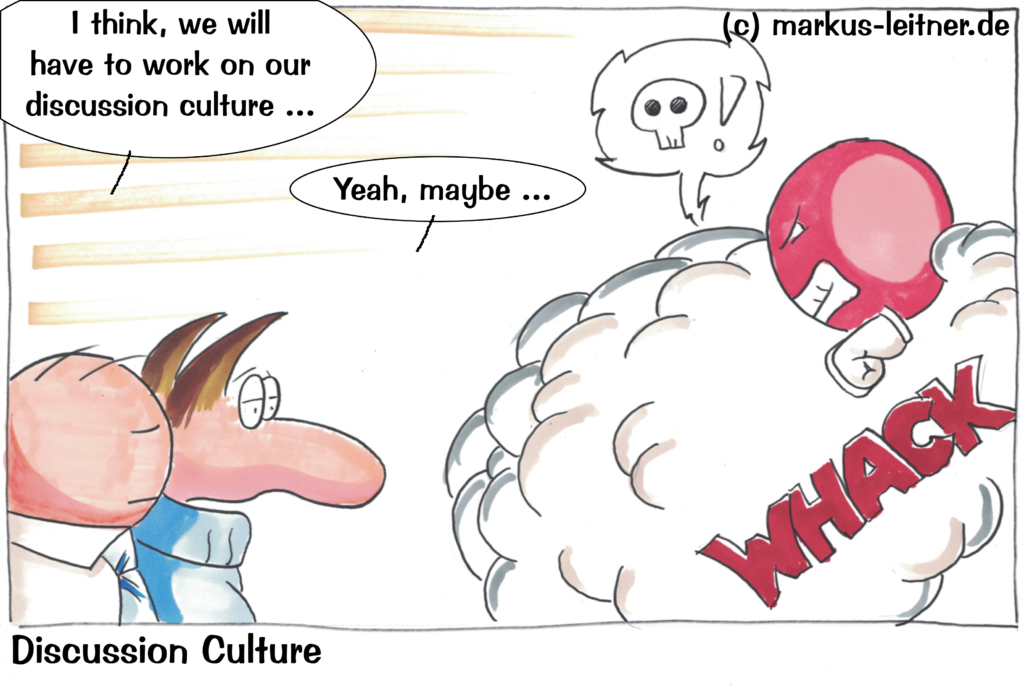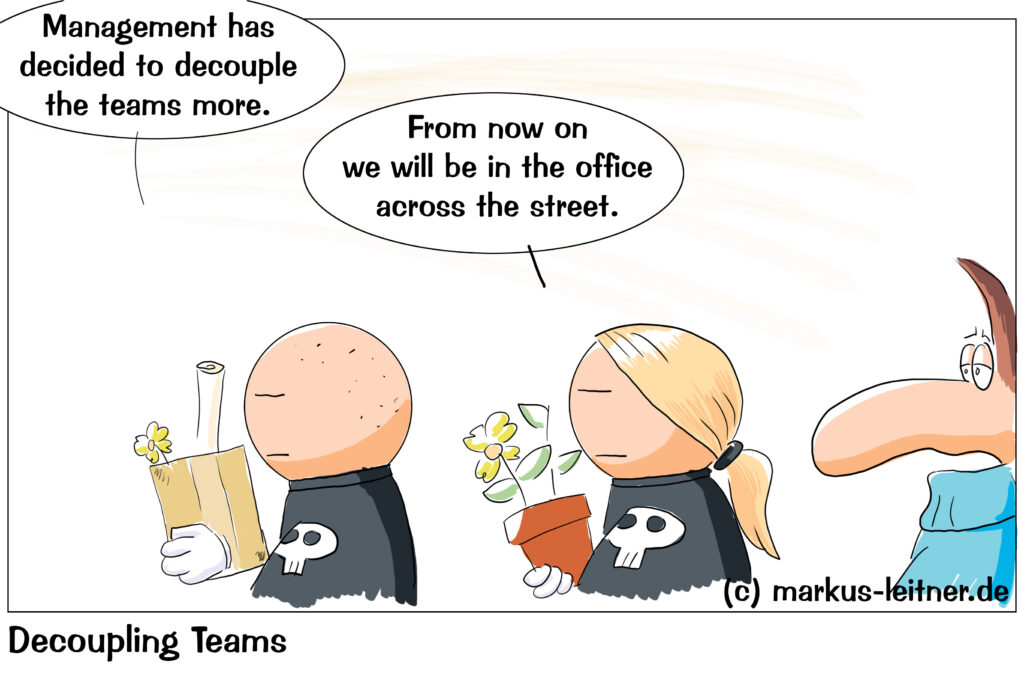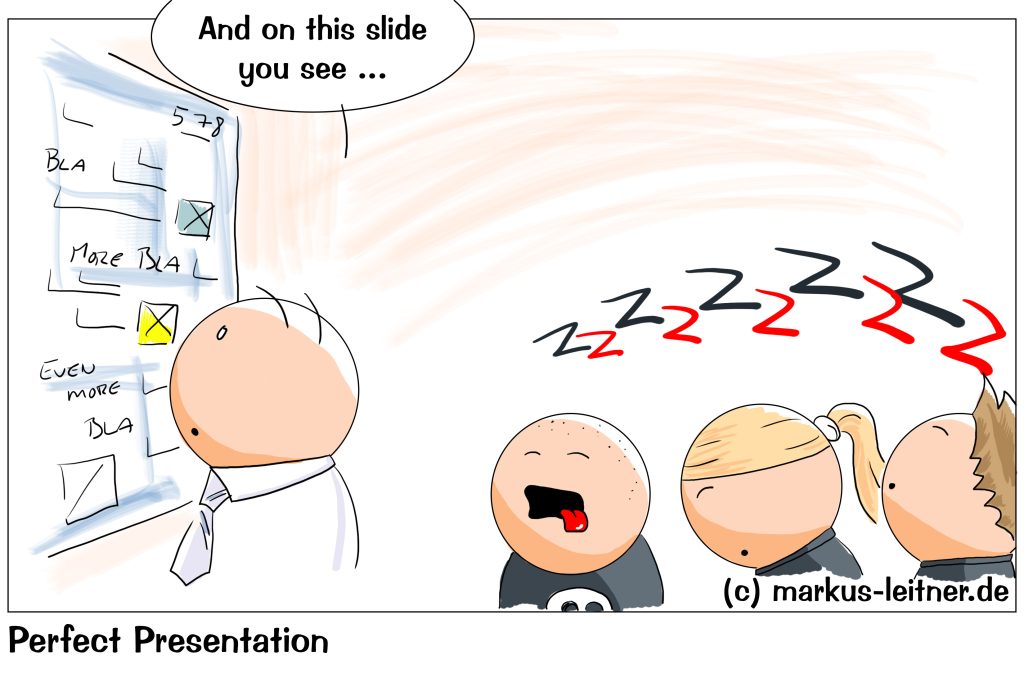
If we ask about waste in any way in any round, meetings are usually mentioned first. Too often we feel like we talk endlessly and achieve nothing. And while everyone claims to have the formula for better, faster meetings, not much is changing. Why is that and how do you really make better meetings?
In every organization – regardless of agile context or not – meetings are held constantly. We want to make decisions together, we want to exchange knowledge, we have to plan and assess. In Scrum usually the Scrum Master is moderator, in all sorts of other rounds someone moderates, because we believe, that moderation cannot be particularly difficult. However, we have already made a serious mistake here. Moderation is much more than just reading the agenda and summarizing the key messages.
We only have the feeling of having participated in a »good« meeting, if we have achieved a concrete result (we were effective) and did not waste much time (we were efficient). What does it take to do exactly that?
Of course, each of us has heard, that there should not be a meeting without a clear goal. Unfortunately, we are all terribly sloppy on this first basic point. We want to exchange ideas is not a goal. Never.
Why do we want to exchange ideas? What is our motivation? What is our pain? What will happen, if we do not do it? There can be no clear goal without a clear motivation. Having difficulties in formulating a clear motivation means that I we will have difficulties to find e reason for a meeting in the first place.
You may have noticed, how often I have just the word clear in these first lines. Without clarity in our motivation, in our goal, in our way, and in our conclusion and next steps, we will never be able to achieve effectivity and efficiency.
A clear goal can only arise from a clear motivation. That is why an exchange as a goal is so difficult and misleading. Why do we want to exchange information? Because another department needs a very specific set of information (and exactly that set of information) in order to perhaps make a decision about how to proceed. If we become aware of the motivation, we also learn a lot about the actual goal. In the case of a knowledge exchange, we learn what knowledge needs to be exchanged. We get to know the limits of our scope through motivation.
In this example, the goal we want to exchange ideas shifts to: Because department X has to plan how to proceed with case Y, it needs the information A, B, C and D. Since we expects multiple questions, we choose the conversation instead of the written exchange.
Such a goal is verifiable – a principle that must apply to any goal, otherwise it is not a goal.
Most likely the entire team will not have to participate in this scenario. Meetings often feel cluttered, and they are, because we are very inconsistent when it comes to the smallest group we need. Inviting a person, because they are complaining, when they are not invited, is not a reason. Never. We invite precisely those people, who can contribute or take something away – not one more.
If things finally start, I start by doing nothing.
Let your colleagues talk and joke around for five minutes. We need this short period of relaxation before we actually start. Ignoring that will only lead to a higher stress level from the very beginning. In too many organizations meetings are placed next to another, meaning that one ends and the next starts immediately. No one has time to breathe, go to the toilet, smoke and take another cup of coffee. If that is the case, stress level is high and calm and focused work will be very difficult.
When there is more than one person jumping from one meeting to another, things get ugly pretty soon. We are stressed and our concentration drops. We notice this from the fact that the moderator has to intervene again and again. The mood changes very quickly, because nobody likes to work under pressure. If we then build up even more pressure by immediately accelerating, we only make sure that everyone’s concentration is on the lowest level possible.
We are far better off, if we let our colleagues relax for a couple of minutes by just talking and joking. That is just an investment. The five-minute-talk between meetings while getting the next coffee is now happening in our meeting, because we have to. Ignoring the need for little breaks will be very expensive in the long run. Trust me.
This is even more important, when everyone is working remote, because there are even more stress factors.
As a moderator, I not only make the agenda clear to everyone involved, but above all the goal and motivation. If these things are clearer, you will automatically discuss more clearly and purposefully yourself. The more ambiguity there is about motivation and goal, the more unclear and frayed the discussion becomes, because everyone sets their own goal and motivation.
It is not only my job to watch the clock or intervene, if the discussion steers off, I have a whole toolbox to facilitate decision making. I do not ask, how we want to make our decision (if that is the goal of our meeting), I have something prepared, or I am experienced enough to do it on the fly.
The job of the moderator is to ensure, that a discussion is effective and efficient. That can only happen, if things run smoothly, but above all we need a way to achieve our goal. If we have to make this way up, we suddenly steer away from our core discussion to a side discussion, where we try do decide on a way to achieve our goal today. Sounds silly, and it is.
If we want to make a decision, our way is basically the same every time: we understand our problem, we collect solution options, we understand the options, we evaluate the options, we make a decision based on our evaluations, we decide on the next steps.
Sticking to this path and separating them from one another, the goal is almost reached. This separation of the individual segments is so important, because it helps us to divide the actually very complex process of a decision into small units. Everyone can follow that. You only have to concentrate on one part of the whole at a time.
Mixing the segments some will already be in the process of finding solutions, while others have not even understood the problem. It should be clear to all of us, that this is a terrible idea. We will notice, that things start to mix up even further. We jump from solution to question to solution to decision and back again. Not only does it feel confused, nobody feels comfortable in this discussion. It is not targeted. So we first clarify all questions of understanding before we visibly conclude this point and move on to the process of collecting possible solutions. By completing an intermediate step in this way, all participants also have the feeling that they have achieved something. That makes the next step easier.
This structure that we achieve makes process visible. Do not underestimate the effect.
In the second part of this mini series we will talk about techniques, the actual decision, and how to proceed. If you need any assistance, just speak to me.
Core: No clear goal without clear motivation. The moderator’s task is to lead the discussion step by step – through understanding, collecting, evaluating, and making decisions. Mixing these sections leads straight into discussion hell.











